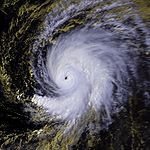1988 Pacific hurricane season
| 1988 Pacific hurricane season | |
|---|---|

Season summary map
|
|
| Seasonal boundaries | |
| First system formed | June 15, 1988 |
| Last system dissipated | November 2, 1988 |
| Strongest storm | |
| Name | Hector |
| • Maximum winds | 145 mph (230 km/h) (1-minute sustained) |
| • Lowest pressure | 935 mbar (hPa; 27.61 inHg) |
| Seasonal statistics | |
| Total depressions | 23 |
| Total storms | 15 |
| Hurricanes | 7 |
| Major hurricanes (Cat. 3+) |
3 |
| Total fatalities | 25 |
| Total damage | Unknown |
| Related articles | |
| Tropical depression (SSHWS) | |
| Duration | June 15 – June 18 |
|---|---|
| Peak intensity | 35 mph (55 km/h) (1-min) |
| Tropical storm (SSHWS) | |
| Duration | June 16 – June 21 |
|---|---|
| Peak intensity | 70 mph (110 km/h) (1-min) 992 mbar (hPa) |
| Tropical storm (SSHWS) | |
| Duration | June 20 – June 22 |
|---|---|
| Peak intensity | 50 mph (85 km/h) (1-min) 1000 mbar (hPa) |
| Tropical depression (SSHWS) | |
| Duration | July 2 – July 4 |
|---|---|
| Peak intensity | 30 mph (45 km/h) (1-min) |
| Category 1 hurricane (SSHWS) | |
| Duration | July 8 – July 15 |
|---|---|
| Peak intensity | 75 mph (120 km/h) (1-min) 994 mbar (hPa) |
| Tropical storm (SSHWS) | |
| Duration | July 19 – July 26 |
|---|---|
| Peak intensity | 65 mph (100 km/h) (1-min) 994 mbar (hPa) |
| Tropical storm (SSHWS) | |
| Duration | July 27 – August 2 |
|---|---|
| Peak intensity | 70 mph (110 km/h) (1-min) 992 mbar (hPa) |
| Category 4 hurricane (SSHWS) | |
| Duration | July 28 – August 9 |
|---|---|
| Peak intensity | 140 mph (220 km/h) (1-min) 943 mbar (hPa) |
| Tropical depression (SSHWS) | |
| Duration | July 28 – July 29 |
|---|---|
| Peak intensity | 30 mph (45 km/h) (1-min) |
The 1988 Pacific hurricane season was a Pacific hurricane season that saw a below-average amount of tropical cyclones form, the first time since 1981. It officially began May 15, 1988, in the eastern Pacific, and June 1, 1988, in the central Pacific and lasted until November 30, 1988. These dates conventionally delimit the period of each year when most tropical cyclones form in the northeastern Pacific Ocean. The first named storm, Tropical Storm Aletta, formed on June 16, and the last-named storm, Tropical Storm Miriam, was previously named Hurricane Joan in the Atlantic Ocean before crossing Central America and re-emerging in the eastern Pacific; Miriam continued westward and dissipated on November 2.
The season produced 23 tropical depressions, of which 15 attained tropical storm status. Seven storms reached hurricane status, three of which became major hurricanes. The strongest storm of the season, Hurricane Hector, formed on July 30 to the south of Mexico and reached peak winds of 145 mph (230 km/h)—Category 4 status—before dissipating over open waters on August 9; Hector was never a threat to land. Tropical Storm Gilma was the only cyclone in the season to make landfall, crossing the Hawaiian Islands, although there were numerous near-misses. Gilma's Hawaiian landfall was unusual, but not unprecedented.
Timeline of tropical activity in 1988 Pacific hurricane season
The total tropical activity in the season was below-average. There were 13 cyclones in the Eastern Pacific, as well as two in the Central. Of the 15 cyclones, one crossed from the Atlantic Ocean into the Pacific, and another moved from the Central Pacific to the Western Pacific. In the Eastern Pacific, there were seven cyclones peaking as a tropical storm, and six hurricanes, of which two reached Category 3 intensity or higher on the Saffir-Simpson Hurricane Scale. A tropical storm and a major hurricane occurred in the Central Pacific.
Tropical Storm Gilma made the only landfalls of the season in the Hawaiian Islands, causing some rainfall, but no direct deaths or damage occurred as a result of it. These were the only landfalls in the season that were made, which is unusual as most landfalls in the Eastern Pacific occur on the Mexican coast. This is due to the closeness of the Mexican region to the major source of tropical activity to the west of Central America. Hurricane Uleki, the strongest hurricane in the Central Pacific region during the season, caused two drownings in Oahu and heavy waves hit the coast of the Hawaiian Islands.Tropical Storm Miriam, the last storm of the season, formed as a result of Hurricane Joan from the Atlantic, and flooding resulted in parts of Central America, due to heavy rainfall.
...
Wikipedia

















